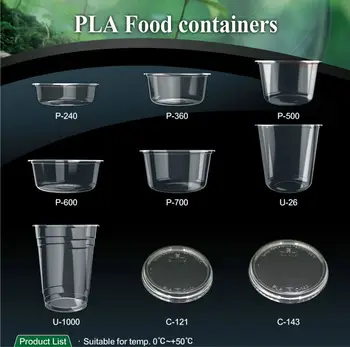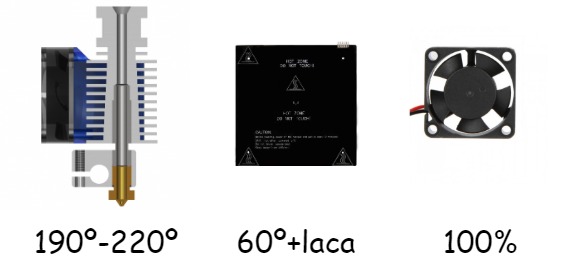PLA is probably the most widely used material in the world for 3D printing. It is a material that is very easy to print on and exists in a huge variety of finishes. Furthermore, contrary to popular belief, PLA is not a very fragile material, and in fact it is more rigid than other materials such as PETG or ABS.
Here we will teach you everything you need to know about PLA in order to use it in your prints with the best possible results.
📖 What do you want to read?
What is PLA?
PLA or polylactic acid is a plastic material, used in the industry for the manufacture of containers due to its properties, similar to those of PET. It is made from corn starch, so this material can be considered biodegradable under certain circumstances of humidity and temperature. In general it is a more eco-friendly material than others such as ABS.

This material is odourless and resistant to chemicals and has an interesting additional quality: it is very easy to combine with other materials to create compounds with incredible properties.
If you’ve been printing in 3D for a while, you may have noticed that the PLA that was sold before was much worse than the one sold now. This is because, due to the boom of 3D printing, a lot of research has been done on combining PLA with other materials to improve its characteristics.
The PLA we can now buy uses a very refined formula, with numerous additives that improve its dimensional stability, increase its flexibility so that it is less brittle, improve its temperature resistance, etc.
In addition, there are many manufacturers that market improved versions of PLA such as PLA+ or PLA 870.

PLA Properties: PLA vs PETG vs ABS
PLA clearly cannot win in terms of resistance against materials such as PETG or ABS, but it certainly has properties that make it stand out in many respects.
- Rigidity: PLA is a very rigid material, much more so than ABS or PETG. This means that it will be more resistant to deformation. The downside of high rigidity is that the material is more brittle. In applications where the rigidity of the material is important and high mechanical strength is not required, PLA is a very strong choice.
- Surface quality: Although most current printers can handle materials such as PETG or ABS, PLA is, in most cases, the one that is printed with the highest surface quality. This is partly due to the lower melting temperature used compared to other materials. This, added to the fact that it does not suffer from delamination when a coating fan is used, helps us to always obtain the best finishes.
- Health: PLA, as mentioned above, is a material suitable for food use, so it can be used to make utensils that will come into contact with food. In fact, PLA is commonly used in industry to make food containers and packaging. PETG is food-safe too, but when melted at a higher temperature it can be somewhat less safe, since, for example, melting PETG at 240 degrees can cause some PLA particles to be calcined and remain in our hotend.
- Compatibility with other polymers: As we said before, PLA can be formulated in conjunction with other materials, to alter its properties and improve them. There are many brands that market different types of PLA with added properties, such as increased temperature or impact resistance.
When to choose PLA?
We must use PLA whenever the priority of our piece is the quality of finish. In addition to its properties such as rapid cooling, PLA is marketed in a much wider range of colors than other materials. If we need incredible colors, shiny, with glitter, with multicolor particles or with any other fantasy finish, PLA is undoubtedly the choice.
On the other hand, PLA is by no means a brittle material, even though it is more fragile than ABS or PETG. This is why PLA remains a viable alternative for pieces that require moderate resistance and especially wherever the piece must be as rigid as possible.
If we need exotic materials, such as wood fibers, surely the filaments we will find are formulated with a PLA base, so, even without knowing it, when we print them we will be printing in PLA.
Other interesting PLA features
We have told you about the major advantages that PLA has over PETG or ABS, but this material has some other properties that may be interesting.
- No smell when printing: You may have noticed that PLA does not smell when it is printed, which is very convenient. Besides the convenience, this means that it is not emitting some of the toxic particles that other materials, such as ABS, do.
- Chemical Resistance: PLA is a very stable material, and so it is quite resistant to chemicals such as acetones or alcohols. Very powerful solvents such as dichloromethane are required to dissolve PLA, so everyday chemicals will not make a dent in PLA.
- Compostable: PLA can be composted (turned into fertilizer or manure) by being in a hot (usually above 60 degrees) and very humid environment.
- Deformability at high temperatures: PLA deforms when temperatures exceed 60-70 degrees, so one way to make very original parts is to heat them (with a heat gun or by putting them on the printer bed for a while) and deform them carefully to give them a curious shape. If you think it is an interesting idea do not hesitate to leave us a comment so that we can show you what can be achieved with this technique.
How to print PLA?
The PLA, as we have said, stands out for its ease of printing with good finishes, but we want to give you some short tips to get the best results.
- Printing temperature: In this case it depends quite a bit on the formulation, since some manufacturers use different additives to improve PLA. In most cases, printing temperatures vary between 190 and 220 degrees, but it is better to follow the manufacturer’s instructions.
- Layer fan: In PLA the higher the coating ventilation, the better the finish, especially in areas such as overhangs or very thin areas. We must put our layer fan at 100% once the first layer or layers are over. In some printers it is advisable to modify the ventilation to obtain a better air flow and improve the finishes.
- Printing base: PLA can be printed in almost any condition. It can be printed with a hot base, without a hot base, with glass, without glass, with buildtak type surfaces, with lacquer, with glue… From our experience we recommend a moderate bed temperature of about 60 degrees to help adherence and a little lacquer in case you do not have an adherent surface.

Conclusions
PLA, as we have seen, can be printed very easily and usually produces very good finishes. In addition, it is available in a huge range of colors and finishes. Its mechanical resistance is not as high as that of other materials, but this does not mean that it is a material that will break with normal use. In addition, it is a biodegradable material and does not smell when printed.
And you, do you have any questions? If so, leave us a comment and we will be happy to answer you!
